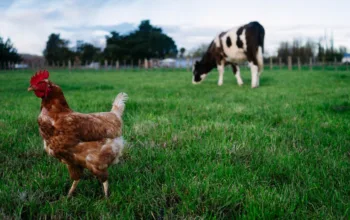Factory farming’s disaster problem, explained.
An explosion and fire at a dairy farm on Monday in the Texas panhandle has been called the deadliest cattle barn fire ever recorded: it left one worker in critical condition and killed 18,000 cows.
The cause of the fire, which occurred at South Fork Dairy Farm in Dimmitt, 75 miles northwest of Lubbock, is still under investigation by the state fire marshal. In an interview with a local news station, Castro County Sheriff Sal Rivera said it may have been caused by the facility’s manure management equipment. “It is possible that it overheated and the methane and things like that might have ignited and spread out with an explosion and a fire,” he said.
Fires on large-scale animal farms, or factory farms, are surprisingly common. Over the last decade, at least 6.5 million farmed animals, mostly chickens, perished in barn fires in the US, according to Washington, DC-based nonprofit Animal Welfare Institute (AWI).
/cdn.vox-cdn.com/uploads/chorus_asset/file/24585563/Ahn6b_at_least_6_5_million_farmed_animals_died_by_fire_in_the_past_decade_the_true_death_count_is_likely_far_higher_nbsp_.png)
The fires are part of a broader pattern of mass casualty events on factory farms, where 99 percent of America’s meat, dairy, and eggs are produced. Some are the result of human or mechanical error, but many stem from natural disasters, such as hurricanes, blizzards, and extreme temperatures, like last summer’s scorching heat wave in Kansas that killed thousands of cows who were subsequently dumped in a landfill. Disease outbreaks, too, result in mass death or culling on farms.
The Dimmitt fire, however, was unusual in its scale. Because the farm was enormous — with reportedly 19,000 cattle, it was among the biggest dairy farms in the country — it killed an order of magnitude more cows than are typically killed in fires, enough to fill 26 football fields, according to a USA Today analysis. For context, the largest number of cows killed in a single fire between 2018 and 2021 in the US was 548.
“What’s so striking about this incident in Texas is just the sheer number of animals that were on the operation in one building to begin with,” said Allie Granger, a policy associate with AWI.
Frank Brand, who operates the South Fork farm, said he couldn’t provide comment when he was reached by phone Thursday.
High death tolls could be more likely in the future as mega-factory farms proliferate, packing ever more animals into cramped warehouse-sized sheds. From 1992 to 2017, the number of US farms with 1,000 or more dairy cows has more than tripled, even as the total number of dairy cows has remained about the same.
Factory farm fires, explained
“Fires at livestock and poultry production and storage properties are quite common and have been for years,” the National Fire Protection Association reported earlier this year. Animal farms don’t have the same fire codes and safety requirements as buildings designed for humans. Farms often lack fire alarms and sprinklers, and they’re filled with flammable materials like hay. Barn fires are typically caused by malfunctioning heating or electrical systems, according to the NFPA, and are more common in colder states in the Midwest and Northeast.
Fires at large, industrial-scale facilities are particularly concerning because they can wipe out so many animals at once. Chicken factory farms can house hundreds of thousands or even millions of animals each year, so a single fire at one of these facilities can account for the majority of barn fire deaths in a year. Chickens account for about 92 percent of the 6.5 million animals killed in barn fires, with pigs comprising about 2 percent and cows less than 1 percent.
/cdn.vox-cdn.com/uploads/chorus_asset/file/24585567/jmjV3_nearly_all_animals_who_die_by_fire_are_chickens_because_there_are_so_many_chickens___2_.png)
The true number is likely significantly higher, AWI notes, because not all states have the same reporting requirements, and because farm animals are property with essentially no legal protection from suffering. Media reports of these incidents often focus on financial losses to farm owners, rather than the immense suffering of farmed animals who burn to death.
Putting out the fire on America’s farms
Fires aren’t totally avoidable, but more state agencies could help mitigate the risk by adopting the National Fire Protection Association’s Fire and Life Safety in Animal Housing Facilities Code, which requires fire protection measures on farms. The latest edition, published in 2022, requires annual fire hazard inspections, contacting emergency services when alarms go off, fire drills, employee training, and minimum spacing between buildings. Only a few states have adopted the code for farms.
Meat, dairy, and egg producers themselves could implement relatively straightforward reforms to prevent fires, according to Granger: conduct proactive fire safety inspections alongside fire officials and experts, ensure equipment is routinely checked and maintained, and institute worker training and emergency planning.
/cdn.vox-cdn.com/uploads/chorus_asset/file/24585592/WAM21511.jpg)
Jo-Anne McArthur/We Animals Media
“Unfortunately, the industry has not taken upon themselves to adopt the code and their own standards and guidelines that they use as a part of their certification programs or auditing programs,” Granger said.
The reporting system for barn fires could also be improved in order to better understand its scope — fire officials often fail to include the number of animals who’ve died in their incident reports.
The more fundamental problem, though, is factory farms’ size, which can make for disturbingly high death counts from fires and other disasters, and can make them harder to prevent and contain.
That was evident, for example, in last year’s bird flu outbreak, in which the poultry industry resorted to exterminating tens of millions of farmed birds through a ghastly method called “ventilation shutdown plus,” essentially killing them via heatstroke. In a letter last May, Gwendolen Reyes-Illg, a veterinary adviser to AWI, urged the nation’s largest veterinary association to advocate for restrictions on factory farm size, arguing that the spread of mega-factory farms was contributing to the use of that cruel method because meat producers found it impractical to deploy other cull methods in such large facilities.
/cdn.vox-cdn.com/uploads/chorus_asset/file/24585897/WAM7290.jpg)
Jo-Anne McArthur/We Animals Media
For many types of natural disasters and disease outbreaks — although not for barn fires unless they began as a wildfire — meat producers receive taxpayer-funded reimbursements to recoup their losses, and there’s been recent movement in Congress to hold the livestock industry accountable for such disasters. Late last year, Sen. Cory Booker (D-NJ) introduced a bill that, among other provisions, requires large meat and egg producers to prepare for disasters and pay the costs of dealing with them, including cleanup and disposal of animal carcasses. The idea is that forcing the industry to internalize some of its risk would prevent producers from inflicting harm for free.
The bill stands little chance of moving through this Congress, but it’s a sign, among others, that the public health and environmental problems wrought by factory farming are becoming increasingly difficult for Washington to ignore. For America’s big agricultural states, including Texas — where everything’s bigger — the Dimmitt tragedy should be a wakeup call about the risks of a food system increasingly dependent on super-sized factory farms.



